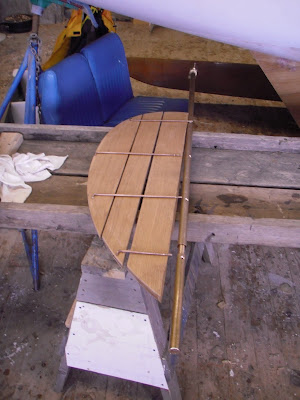As promised, we had a launching last week. All the new kids finished their Susan Skiffs, and the "seniors" completed the 2 fancy small boats started last fall. Unfortunately with 6 boats being launched there are a lot of people around, so I never got a good shot, but they looked great all sitting there on the beach.

All the builders (except Jamie, who graduated last december). From left to right, we have Doug, Josh (along with Jamie, my partner on the Twin project), Thor, Sarah, Andrew, Jeff, Matt, Hobbes, Phil (the intern. . . who built his boat alone as quickly as everyone else built theirs in pairs), Adam, and Drew.

Soon after that shot was taken. . . boats in the water. It's like a little armada out there.

The Whitehall. . .

And the A&R. . .

Back in the shop, I've been doing some shopping.

The collection of fittings has started. Besides these pieces (only about 1/3 of the fittings we'll buy), we've also had the the rudder post system fabricated (pics next time) and I've bought some bronze plate for fabricating some of the easier pieces. About $5,000 worth of bronze on this little boat (not counting the fasteners already in the boat). This is probably a good of time as any to talk about the economics of wooden boat building. I've kept a semi-close eye on expenses for this boat and here is my estimate of raw materials. . .
Bronze fittings $5,000
Sail (incl. rigging rod/track) $4,000
Wood $5,000
Mold/Jigs $800
Fastenings $3,000
Paint/Epoxy/Varnish $1000
Other $400
Total $19,200
Now add in depreciation costs for tools, the cost of heat, leasing a building, etc. . . and we haven't even gotten to labor costs yet. Sure, we are apprentices and it is taking us a year to do what the pros could do in a few months. But I'd imagine they would still like to get paid a little bit so they can eat and build another boat someday. Price on the mermaid today (from the apprenticeshop, where labor is free and fixed costs are subsidized by donations) is $30K. A steal at twice the price. My guess is a real boatyard would have to charge around $70K for this boat.
Back to the shop, and the business of making stuff. I've been varnishing the spars, so not much happening there. In the meantime, I've been working on the chainplates and their blocking. The chainplates are little bronze straps attached to the hull which you attach the shrouds to. The shrouds are the wires that run from the side of the boat to the top (or near top) of the mast, holding the mast in place. When going upwind, that's a lot of stress transferred to the hull, so things need to be solid.
Here is a quick shot of the actual chainplate. Just a piece of 1/4" bronze plate with a hole in the top, bent to the shape of the hull. No big deal. The real fun is the blocking.

Here is my first attempt. Seemed reasonable enough. I made a pattern of the shape of the hull, and cut out the block to that shape. It's subtle, but the back face of this piece is curved. . . think of the side cross section of the boat. Flat up top near the sheer, then curving down to meet the keel. Then I cut out the block so it will fit snug between the sheer clamp and the planking. Now it is just a matter of slipping this block under the clamp up and flush with the bottom of the clamp, bottom of the deck and inside of the planking. By the way, the slot in the deck in the upper left corner of this picture is where the bronze plate comes through.

See the problem yet? This block is impossible to install. It will fit, but to slide it under the clamp I have to start 4" below where it eventually will reside. The boat really starts to curve towards the keel there, so the block gets pinched between the clamp and the planking. If the frames weren't in the way we could go at this sideways, but, of course, they are. The correct answer is to install these things before the sheer clamp (i.e. 4 months ago). A bad solution is to shave off the top of the block until it fits, but then you don't have much of a backing block, do you?
Here is the actual solution. . . cut the block in half.

After a little bit of futzing and slotting out the back of the blocks to accept the plate. . . voila!

The bronze will bet clipped off at the bottom and the holes (just screw holes to hold the pieces together while I shaped them) will be filled and painted over, so these should look like solid blocks when all is said and done. The wedging action holds everything in place tightly, so installing the fasteners will be a breeze. One final shot which should give you an overall view of what is going on. . . keeping in mind the cockpit combing is causing a little illusion. The chainplates and their blocking are about 7 or 8 inches behind the combing, more or less parallel with it.

Next up. . . the rudder.
 After a short speech and a little champagne . . . off we go.
After a short speech and a little champagne . . . off we go.

 She sailed really smoothly. Even in the light air, when the wind caught the sails, she picked up speed quickly. The tiller was touchy, giving her a sporty feel.
She sailed really smoothly. Even in the light air, when the wind caught the sails, she picked up speed quickly. The tiller was touchy, giving her a sporty feel.
















































